
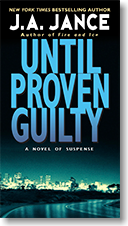 BUY NOWFAITH CAN BE DANGEROUS
BUY NOWFAITH CAN BE DANGEROUS
LOVE CAN KILL
The little girl was found with her pink nightgown twisted around her throat. She was only five. The woman who came to the funeral and threw a single rose on the little girl’s coffin was alive and beautiful. . .the kind of beautiful that Homicide Detective J. P. Beaumont couldn’t resist.
Beau saw the little girl’s battered body. And he saw the insane eyes of the “Reverend” who ran Faith Tabernacle where little children were beaten and punished for the sake of salvation.
J. P. Beaumont was certain he had his man . . . as certain as he was of the beautiful woman he wanted to spend his life with. But lurking in the dark corners of this bizarre case was not just a demented mind obsessed with murder . . . not just a series of murders about to happen . . . but secrets so deadly, so close to Beaumont’s life, that even a street-tough cop could die guessing.
In the early 1980s I had a chance encounter with what eventually turned into a full-blown cult. When I set out to write the first Beaumont book, I took a Bible and a Concordance and then used scripture passages to justify all kinds of strange behavior. When I realized the book was going to be published, I worried about whether or not the cult members would see themselves reflected in the story. I needn’t have worried. It turned out, those folks really liked the book. That’s one of the happy miracles of writing fiction.
I was in the life insurance business. Even after my divorce, there was a life insurance policy on which I was both owner and beneficiary. When my former husband died, I invested $5000 of the proceeds in a computer–a dual floppy Eagle–and a Daisy Wheel printer. That computer had 128 K of memory, so when my word processor, a program called Spellbinder, was loaded into the computer, there was only 15 K left in the work space.
The reason the first books have such short, punchy chapters was due to the fact that if they were any longer than 15 K, the cursor would freeze up. It was while I was writing the third book, Trial by Fury, that I met and married my second husband, an electronics engineer. He took my computer apart and added more memory with the result that the chapters were able to be a little longer and a lot more graceful.
JAJ
AVON (1985) ISBN 0-380-89638-9
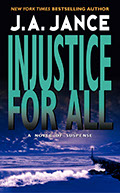 BUY NOWHER NAME IS GINGER
BUY NOWHER NAME IS GINGER
HANDLE ACCORDINGLY
It was like a scene from a movie: the beautiful blond screaming on a Washington beach, a dead man lying at her feet; the dashing homicide detective arriving to offer kindness and solace to the distressed lady. What it wasn’t was a restful vacation for Homicide Detective J. P. Beaumont. And now a murderous mix of politics and passion is turning Beau’s holiday into a nightmare–and leading the dedicated Seattle cop into the path of a killer whose blood lust is rapidly becoming an obsession.
While writing the second Beaumont book, I came up against intractable characters for the first time. Fifty pages from the end of the book, I found out that the person I thought was the killer didn’t do it. “Didn’t you have to go back and change the clues?” people asked. And the answer was no. The guy I thought was the killer was innocent the whole time.
While I was writing this book, I was living in a high rise condo. During a temper tantrum, my son threw something down the garbage chute-- something that shouldn't have gone there. Bent on retrieving the item, we headed for the garbage room in the basement. It was the end of a three day weekend. Garbage was backed up into the chute. It took a long time before we finally managed to find and retrieve the missing item. But, as I said earlier–for a writer everything is usable. When it’s time for Beau to go Dumpster diving in Injustice for All, I really knew whereof I spoke.
JAJ
AVON (1986) ISBN 0-360-89641-9
 BUY NOWOF DEATH AND THE DUMPSTER
BUY NOWOF DEATH AND THE DUMPSTER
The body lying naked and dead in a Seattle Dumpster was a shock. But even more shocking was the manner in which he died. The victim, a popular high school basketball coach, was lynched–a grim echo from a dark past–leaving behind a very pregnant wife with a very dangerous secret. A sixth sense developed over twenty years on the job tells Homicide detective J. P. Beaumont that this investigation is going to the lethal extremes–of passion, lies and hatred; of the wrong kind of love and the worst kind of justice.
When I first arrived in Seattle in 1981, I was dead broke. My daughter wanted desperately to go to Girl Scout camp, but the only way to make that happen was for her to sell Girl Scout Cookies–one thousand boxes a year, three years in a row. One of the places she sold cookies was outside a supermarket on Seattle’s Queen Anne Hill. It was during those hours that I learned Girl Scout Cookie season and the Washington State high school basketball tournament ran at the same time. So when readers encounter the girl who’s out selling her cookies, they may be interested in knowing that they’re meeting up with the author and her daughter making cameo appearances in the story.
I’ve always been opposed to outlines–from sixth grade on. When my editor needed to go to a cover meeting for this book, I told him how I thought the book would end. But thinking and doing are two different things. By the time I finished writing the manuscript, the ending had changed. Unfortunately, the cover had not, so I went back and changed the ending so it matched the cover. This was my first bad experience in the Byzantine world of cover art; it would not be my last.
JAJ
AVON (1986) ISBN 0-380-75138-0
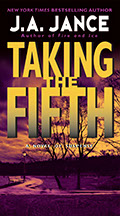 BUY NOWHAVE SHOE
BUY NOWHAVE SHOE
WILL MURDER
It seemed like a most unlikely instrument of death: a lady’s cobalt blue pump with stiletto heels. But the fact that it was caked with the blood of–and found damningly close to–a very dead man gives Seattle Homicide Detective J.P. Beaumont a solid lead into a case of lethal theatrics and unsavory union doings. He has a pay stub, a matchbook, one corpse–and an unsettling feeling of more to come. And he has a murder weapon. All Beau has to do now is find the woman who fills it.
My cousin, Polly Johnson, a gospel singer who hailed from Rapid City, South Dakota was on a plane that was blown up over northern California in one of this country’s first airplane hijackings. The character of Jasmine Day/Mary Lou Gibbons is my way of paying tribute to Polly.
In addition, one of my life insurance clients, a man who had purchased a disability policy from me, was one of the first patients to die of AIDS in Seattle. Even though I had left the insurance business by the time he became ill, his partner called me for help when the insurance company was reluctant to pay the claim. I spoke to the claims department and was told, “The man has AIDS. He must have known he was sick when he bought the policy.” “If he had known he was sick,” I returned, “he would have bought life insurance not disability.” The upshot was that the claim was paid but probably not for more than two or three months before he was gone. Part of the background for Taking the Fifth (the fourth Detective Beaumont book) comes from what I experienced during that time.
JAJ
AVON (1987) ISBN 0-380-75139-9
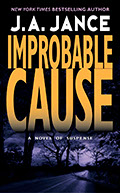 BUY NOWEYE FOR EYE
BUY NOWEYE FOR EYE
TOOTH FOR TOOTH
Perhaps it was fitting justice: a dentist who was overly fond of administering pain found murdered in his own chair. The question for Seattle Homicide Detective J. P. Beaumont is not so much who wanted Dr. Frederick Nielson dead, but rather who of the many finally reached the breaking point. There’s something particularly sordid about this investigation and its subsequent revelations of violence, cruelty, infidelity and sexual abuse. But the most damning piece of evidence is one that will shake Beau to the core of his beliefs . . . and reveal to him the true meaning of evil.
Growing up with a dentist who didn’t believe in using Novocaine left me as a white-knuckled dental patient as an adult–until I wrote this book, that is. Somehow having a dead dentist on the first page fixed me. At a class reunion years later, I found out that some of my fellow classmates and patients aren’t over it yet, but then they don’t write murder mysteries.
This is the fifth Beaumont book. Each time I start a series book, writing the first few chapters is like walking a tightrope. I have to introduce all the on-going characters in a way that will give new readers enough background so they’ll feel as though they’ve read a complete book. This has to be done in a way that doesn’t bore my long-term readers. As I was struggling to write this book, my husband (my second husband, the nice one) stopped by my desk to ask how I was doing.
“Terrible,” I muttered. “This is so boring, I can’t imagine why anyone would read this book.”
“Isn’t this your little old lady book?” he asked.
I nodded.
“And aren’t they a little dotty?”
“Yes.”
“Why don’t you give one of them a parrot?”
He walked away then, and I turned back to the computer. For the next forty five minutes, I typed madly as the parrot scene came into focus. As soon as it did, I was inside the book and it came together.
Writing this book also owes something to the mother of one of the girls in my Girl Scout troop. The mother was a docent at the Woodland Park Zoo and suggested I put something about the zoo in one of my books. As a result of her interest, we had a wonderful tour of the Woodland Park Zoo with special emphasis on the Elephant Compound where we learned that being an elephant handler is the most dangerous job in this country.
JAJ
AVON (1987) ISBN 0-380-75412-6
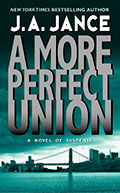 BUY NOWA LESS THAN PERFECT MURDER
BUY NOWA LESS THAN PERFECT MURDER
The front-page photo was a gruesome heartstopper–a young woman plunging from a skeletal skyscraper, sheer horror frozen on her beautiful face. An accident? Suicide? Detective J. P. Beaumont didn't think so. Especially when the body count started climbing,eventually leading him to the headquarters of the ironworkers’ local– and a crew of hardhats with nerves of steel and some deadly secrets. Beaumont is to make the union pay its dues . . . but the union has something else in mind.
When he wasn't going to the University of Arizona or teaching school, my first husband was an ironworker. In the eighteen years I was with him, I never met an ironworker with a “good” wife, and I certainly never met one with a “good ex-wife.” This book was written in 1987, seven years after my divorce and five years after my husband's death. I think it's plain to see that I still had issues with ironworkers.
When I first came to Seattle, the phone company was building a downtown high-rise in Seattle which they chronicled, from demolition to topping out, with photos taken every thirty minutes. The result, when viewed in video form, is fascinating. It was seeing that video that gave me the idea for writing this book.
Also, at the time, I took a tour of Lake Union Dry dock at the south end of Seattle's Lake Union. The man who took me around was the owner, Hobie Stebbens. Years later, my second husband and I encountered Hobie again when we purchased his father's (Hobie I’s) house in Bellevue. I'm sitting in the living room of that house as I write this and trying to keep from humming It's a Small World After All.
JAJ
AVON (1988) ISBN 0-380-75413-4
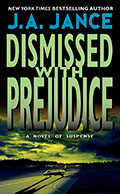 BUY NOWTHE MARK OF A CARELESS KILLER
BUY NOWTHE MARK OF A CARELESS KILLER
Tadeo Kurobashi loved poetry, studied Samurai history, and operated his own software company. When they found him dead on the floor with a Samurai sword by his hand, it looked like hari-kiri. Except for one thing. An error in the ancient ritual pointed to . . .murder.
Growing up in Southeastern Arizona and going to school there as well, I learned almost nothing about the internment of Japanese Americans during World War II. When I moved to Seattle in the early 1980s, I was dismayed to discover this blind spot. I hoped that writing this story might cause a few people with similar blind spots to learn something.
I wrote this book as a work of fiction, but within days of its publication, a group of Japanese businessmen set up shop in the Bellevue Red Lion and advertised for people who may have come home from World War II with Samurai swords to bring the weapons by to be evaluated and possibly purchased for return to Japan as cultural treasures.
Speaking of cultural treasures, if you have visited Seattle without trying the Pecos Pit Barbecue on South First Avenue, you’re missing a treat. It’s only open during weekdays, from 11:30 to 2:30 or so (depending on when they run out of beef!) and you can count on standing in line, rain or shine, but it’s well worth the trip and waiting in line. Just tell them Beau sent you. They’ll know what you mean. Warning: Order your barbecue mild unless you have asbestos-lined taste buds.
PS. Warning: to all readers who are experts in Appaloosa horses. I already have several letters in hand setting me straight. I now know quite definitively that Appaloosas are pure-bred as opposed to thorough-bred. Please don’t tell me again.
JAJ
AVON (1989) ISBN 0-380-75547-5
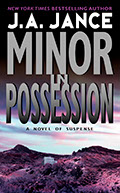 BUY NOWA STIFF SHOT OF MURDER
BUY NOWA STIFF SHOT OF MURDER
The Arizona alcohol rehab ranch was no picnic for J. P. Beaumont. First they stuck him in a room with a sleazy, teenage drug dealer named Joey Rothman. Then they sicced the local law on him when the punk was discovered shot dead with Beaumont’s own .38. But the party responsible for Joey’s early check-out wasn’t satisfied with simply framing Beau for murder. Suddenly the Seattle detective faced a choice of fates far more unpleasant than cold turkey: a long stay in the State cooler . . . or an even longer one beneath the cold, cold ground.
When I began writing the Beaumont books, I hadn’t taken any creative writing courses, but I was smart enough to figure out that I needed to write what I knew. I had lived with an alcoholic for eighteen years, so in creating my detective’s character, I had him doing the same kind of drinking I was accustomed to.
I was doing a signing of the fourth book, Taking the Fifth. (Please don’t ask why I didn’t name the fifth book Taking the Fifth. It would have been much easier to remember.) A woman came up to the table. “You know,” she said in a hushed, confidential voice, “Beau drinks every day. He has a drink of choice, and it’s starting to interfere with his work. Does J. P. Beaumont have a problem?”
I shrugged her off because it was clear to me that my books were simply stories. But in the course of the thirty-odd signings I did for that book, six other people asked me pretty much the same question. Finally, the light came on. Alcoholism is a disease of denial. No wonder I was the last one to figure it out. That’s how, four books later, J. P. Beaumont ends up in a rehab ranch near Wickenburg, Arizona.
I don’t suppose it’s much of a coincidence to discover that after I'd filed for a divorce, my soon-to-be-former husband also ended up at a rehab place near Wickenburg. He was there for six weeks, and the counselors were after me day and night to come to Family Week. I resisted, argued, and railed, but eventually I went, and it was important that I did so. My husband was drinking again within days of the end of his six week stay, but my Family Week experience constituted the beginning of my own recovery.
The drinking part of the Beaumont back story provokes two entirely different reactions. There are people who much preferred Beau when he was drinking and carousing. There are others who tell me quietly that they’re glad he sobered up. I’ve also received four separate fan letters from people who have written to me from treatment saying they figured out that if their friend J.P. had a problem, so did they. To both sides of this issue I can only quote an old friend who told me once, “Honey, thank God we’re not all just alike. Otherwise we’d all be married to the same man and drive a Mustang.”
JAJ
AVON (1990) ISBN 0-380-75546-7
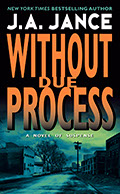 BUY NOWDETECTIVE BEAUMONT HAS
BUY NOWDETECTIVE BEAUMONT HAS
FOUND YOU
A TEDDY BEAR
A maniac broke into the home of Officer Benjamin Harrison Weston–then brutally snuffed the model cop, his wife and his children. But five-year-old “Junior” Weston was hiding in a closet . . . and somehow avoided the psycho’s bloody blade.
Everyone loved and admired “Gentle Ben” –but now the brass is suggesting he was dirty. Homicide detective J.P. Beaumont isn’t about to let anyone drag his dead friend’s reputation through the mud. And he’ll trail a killer from the savage, gang-ruled streets into the upper ranks of Seattle P.D., if necessary–to save a scared little boy who knows too much to live.
At our house, writing a book has always been a group activity. As I started this one, my daughter told me about The Teddy Bear Patrol, a radio station-sponsored program that puts teddy bears in emergency vehicles–patrol cars, fire trucks, and ambulances–to give to traumatized kids. It sounded like a good idea to me, so into the book it went.
Because this book also deals with gangs, I interviewed one of the gang unit detectives. Then, when the manuscript was finished, I had him read it to make sure I hadn’t made any gang unit mistakes. He critiqued my gang unit details and told me he thought those were right. Then he went on to tell me about the first time he needed to use a Teddy Bear Patrol teddy bear. As he talked about handing over a teddy bear to a hungry three-year-old in a filthy crack house, tears rolled down the detective's cheeks. I knew without his telling me that I had that part right, too.
While my children were in school in the Seattle Public School district, they had an outstanding principal named Ed James. The fictional school principal who turns up at the Weston household in the aftermath of the home invasion case is my personal tribute to Ed.
JAJ
AVON (1993) ISBN 0-380-75837-7
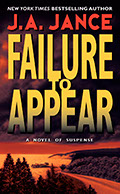 BUY NOWMY FIRST WIFEʼS SECOND HUSBAND
BUY NOWMY FIRST WIFEʼS SECOND HUSBAND
WAS ON THE PHONE,
THAT MEANT TROUBLE
J.P. Beaumont’s teenage daughter Kelly has run off–and her tracks have led the sober-but-struggling sleuth to the Oregon Shakespeare Festival. But in addition to one very headstrong offspring, there is something else waiting for Beau: a case of coldblooded murder.
The victim is an acquaintance–a sleazy rival private investigator brutally butchered, supposedly by the Festival’s current young Juliet . . though Beau has his doubts. But the Second Act is about to open with a second corpse and a touch of kiddie porn–leaving Beau center stage in a heart-stopping tragedy of revenge, deception, and death.
I was busily working away on the second Joanna Brady book one March morning when my editor called from New York to tell me that there had been a marketing meeting. The decision had been made that instead of the next Joanna Brady, they wanted the next Beaumont, but they needed. it by the same deadline, June 1. And so, in the middle of March I started on Failure to Appear. The book went from a dead stop to completion in six weeks during which time my husband claimed I never went to bed since I would still be writing at night when he went to bed and I’d be back up writing when he woke up. Failure to Appear remains to this day one of my favorite Beaumonts. (Yes, authors have favorites, too!)
For fifteen years now, we’ve gone to Ashland, Oregon, every year to enjoy the plays. While my husband was still working, we had to squeeze as many plays as our tails could endure into three grueling days. Now, with him retired, we see six plays in seven days which is a whole lot more civilized. When we went to Ashland the year I wrote Failure to Appear, I had just completed the manuscript. It was odd, because I felt as though I had been there for months. Somehow spending mental time in Ashland was almost as good for me as physically being there.
In the year before and after that book was written, one of our friends became gravely ill. Like Beau’s drinking years before, what was going on in my friend’s life leaked into what I was writing without my being consciously aware of it. Failure to Appear wasn’t dedicated to Larry and Linda Howard, but it should have been.
JAJ
AVON (1994) ISBN 0-380-75839-3
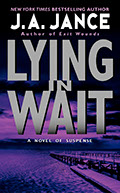 BUY NOWWHAT'S HE DOING ON THE TABLE?
BUY NOWWHAT'S HE DOING ON THE TABLE?
"HANDCUFFS," SHE REPLIED
A Seattle fisherman has died badly–bound, tortured and set ablaze aboard his boat on Puget Sound. And with his death come disturbing questions . . . and the key to a Pandora’s Box of evil that has remained tightly closed for over half a century.
Else Didriksen is no longer the beautiful, troubled teenager who disappeared from detective J.P. Beaumont’s life thirty years earlier. Now she is a homicide victim’s widow–frightened, desperate and trapped in a web of murderous greed that reaches out from a time of unrelenting terror. And the dark, deadly secrets that hold Else prisoner threaten to ensnare Beau and new partner Sue Danielson as well–and to rock their world in ways they never dreamed possible.
When I started writing this book, I knew it had something to do with the Holocaust, but I didn’t know what. I’ve learned through years of writing that opening my mind allows the universe to give me what I need. In this case, it was a chance encounter with a not-yet published book on a Nazi death camp called Sobibor. The author, Thomas Blatt, was one of the few survivors of Sobibor. Because it was a death camp as opposed to a concentration camp, Sobibor left behind only a handful of survivors who staged a daring escape after which the Germans bulldozed the camp, leaving behind an empty field littered with human bones.
Shot during the escape, Thomas Blatt nonetheless survived. He immigrated to the US and, after a successful career in electronics, has devoted his retirement years to letting the outside world know about what went on in Sobibor. I saw this as an opportunity to help in that regard by weaving what I learned from him into the background of this book.
Because this was a book about fishing, I also drew upon the experiences of one of my friends, a retired halibut fisherman. Champagne Al in the book is a fictionalized version of the real Champagne Al, Alan Hoviland who now spends his time framing pictures as opposed to gaffing fish.
While reading this book, readers may notice several real Seattle folks operating as characters under their own names. The right to be characters in this book was an item at several charity auctions in Seattle. That’s how, before the book was written or even had a title, it had already raised $20,000 for Seattle area charities.
JAJ
AVON (1995) ISBN 0-380-71841-3
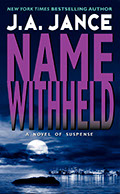 BUY NOWITʼS NEW YEARʼS DAY IN SEATTLE
BUY NOWITʼS NEW YEARʼS DAY IN SEATTLE
PEOPLE ARE DYING AROUND J.P. BEAUMONT.
SO NOTHING, REALLY, IS NEW
Nobody is grieving over the death of Donald Wolf, a biotechnology corporation executive whose numerous criminal activities included illegally trading industrial secrets . . . and rape. Too many people, in fact, are almost too eager to take responsibility for his murder.
At the start of a brand new year, Seattle Homicide Detective J.P. Beaumont has his own life-shattering problems to worry about–from the imminent death of an ex-wife to trumped-up charges of child abuse. But the recently slain body floating in Elliott Bay is pulling Beau back to the job–leading him into a deadly morass of jealousies, personal betrayals, more corpses and corporate double-dealings . . .and closer to a killer he doesn’t really want to find.
Years ago during a book signing a wild-eyed man with cigarettes rolled into the sleeve of his T-shirt wheeled up to the table in his chair and said, “All you people who can walk do the same thing. You think just because someone’s in a chair, he has to be a noble, nice person. Well, we’re not, and I can prove it.”
I was happy to take his word for it, but when it came time to write this book, I thought it was fair to look for someone in a wheel chair who wasn’t “nice.” In doing the research for that character, I was introduced to Northwest Mobility, a Snohomish company that specializes in handicapped vehicle conversions. Hearing their story, I decided to put Northwest Mobility into this book just the way they were.
After the book was written and before it came out, I learned that a woman who had been an important sales rep for me had been diagnosed with ALS, Lou Gehrig’s disease. For a change I was speechless. Holly Turner created the foundation of regional sales that presaged my national sales. I knew enough about ALS to know this was devastating news. I didn’t know if I should call or write and I certainly had no idea what I would say.
I had heard from a friend that Holly’s husband was in the process of remodeling their house to make it wheelchair accessible. A few days after hearing that news, I was out walking my dog and agonizing about whether or not I should call. Suddenly I remembered Northwest Mobility. If Holly's house was being converted to wheelchair accessible, she probably needed a handicapped vehicle conversion as well. I called Holly, telling her about Northwest Mobility. The next time I heard from her was a phone call which she returned from a motel in Florida where she and her husband were traveling in the van they had purchased from Northwest Mobility.
When I put that part in the book, I thought it was something my readers would find interesting. Now I think I was led to put those passages in so I’d have the information when Holly Turner needed it. She succumbed to ALS less than two years after her diagnosis. A short story called Flash of Chrysanthemum in an anthology called Route 66 is my tribute to Holly Turner.
JAJ
AVON (1997) ISBN 0-380-71842-1
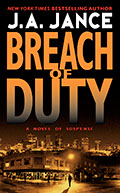 BUY NOWTHERE ARE PEOPLE WHO LIKE CHANGE.
BUY NOWTHERE ARE PEOPLE WHO LIKE CHANGE.
THERE ARE EVEN A FEW WHO THRIVE ON IT.
THATʼS NOT ME
The Seattle that J.P. Beaumont knew as a young policeman is disappearing. The city is awash in the aromas emanating from a glut of coffee bars; the neighborhood outside his condo building has sprouted gallery upon gallery; and even his long cherished diner has evolved into a trendy eatery for local hipsters. But the glam is strictly surface, for the grit under the city’s fingernails is caked with blood. Beau and his new partner Sue Danielson, a struggling single parent, are assigned the murder of an elderly woman torched to death in her bed. As their investigation proceeds, Beau and Sue become embroiled in a perilous series of events that will leave them and their case shattered–and for Beau nothing will ever be the same again.
It’s easy to think that just because Native Americans have largely disappeared from view that their customs and beliefs have disappeared as well. My five years of teaching on the Tohono O’odam reservation west of Tucson convinced me otherwise. J.P. Beaumont learns that same lesson here.
When I was preparing to write this book, I was asked to participate in a Silent Witnesses event. Supporters made cardboard cutouts of all the people (over two hundred) who had died as a result of domestic violence in the state of Washington the previous year. The figures of women and children were first painted red, then their names, dates of birth and dates of death were stenciled onto the red.
The event I attended was held at the Bellevue Art Museum. There, in a room hung with beautiful art, the entire perimeter was lined with those red figures, the Silent Witnesses. At that event I spoke to the mothers and fathers, sisters and brothers of murdered women; to the grandmothers and grandfathers and aunts and uncles of murdered children. The seeds for Breach of Duty were sown in my participation in that event.
JAJ
AVON (2000) ISBN 0-380-71483-X
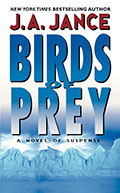 BUY NOWMY WIVES ARE DEAD.
BUY NOWMY WIVES ARE DEAD.
BOTH OF THEM.
J.P. Beaumont is still reeling from the brutal murder of his partner when he volunteers to accompany his elderly grandmother and her new groom on a honeymoon cruise to Alaska. But murder stows away onboard. The first to go is a beautiful but acid-tongued woman who has brought along a tightly knit crew of tough-minded henchwomen who view Beau as a dangerous interloper. When the ring-leader’s horrific fall is captured by a ship’s security camera, it’s clear that a cold-blooded killer lurks somewhere among the Starfire Breeze’s opulently appointed decks. With his own emotions stretched to the breaking point, Beau is embroiled in a terrifying and puzzling case that brings the murder he wants to forget into deadly, point blank focus. And rather than forgetting, Beau may well be next in line to walk a terrorist’s twisted plank.
One of the great things about being a writer is that everything is usable. Two cruises worth of experience went into the research for this book. We left Miami in seventeen foot seas. If it hadn’t been for my Travel Aide bracelets, I would have turned green and stayed in my cabin for the better part of the week. If that constitutes an official product endorsement, so be it.
I write on deadline. That means that I know there is a date certain by which time I must begin writing a book in order to finish it on time. In July of 1999 I was on tour with Outlaw Mountain. My plan was to begin writing the next Beaumont book on August first, as soon as I returned from tour.
Sitting in the Club Lounge of the Kansas City Ritz-Carlton, I was drinking a cup of coffee and minding my own business when suddenly J. P. Beaumont began talking to me. Not only was he talking, it was clear he was on a cruise ship. Like me, Beau isn’t much of a sailor, and I couldn’t have been more surprised to find him on a cruise. So I did the only sensible thing I could do–I went to my room, booted up my computer, and began writing the prologue of the book that became Birds of Prey.
The auction bug bit while I was getting ready to write this book. One person, Marc Alley of Seattle, made a $10,000 donation to the YWCA for the privilege of being a character in Birds of Prey. Because his donation was made to the endowment fund, that donation was matched dollar for dollar. Thank you, Marc, for supporting the YWCA in its important work.
JAJ
AVON (2002) ISBN 0-380-71654-2
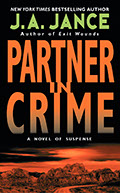 BUY NOWJOANNA BRADY
BUY NOWJOANNA BRADY
J.P. BEAUMONT
TOGETHER AT LAST
An up-and-coming African American artist has been murdered on Sheriff Joanna Brady’s turf in Cochise County, Arizona. Unfortunately the victim happens to be in the Washington State Attorney General’s Witness Protection Program. As the most recent hire in AG’s Special Homicide Investigation Team, J.P. Beaumont gets the call. He reluctantly heads off for Bisbee, Arizona where he tangles not only with Joanna Brady and a contract killer but with some of his own personal demons as well. When two top-drawer and independent minded investigators head-on, you can’t expect the result to be sweetness and light. After all, sometimes having two lead detectives on a single case is one detective too many.
People often want to know where stories come from. Here’s the deal with Partner in Crime.
When Desert Heat, the first Joanna Brady book came out, people began asking me if Arizona’s Sheriff Brady and Seattle’s J.P. Beaumont were ever going to meet. I knew that in order to write such a story, I would have to willingly suspend my disbelief for the six months to a year it would take for me to write such a book. Based on that, my initial reaction was to dismiss the whole idea.
In both fiction and real life, the Cochise County Justice Center is beautifully built. Unfortunately the architect of the real project was longer on aesthetics than he was on security. As a result, he created a jail that didn’t necessarily include a total commitment to keeping jail inmates inside.
Not long after the real facility opened, four jail prisoners let themselves out, went up the road a couple of miles, attacked an elderly couple, tied up the woman, murdered the man, and then stole all the couple’s worldly goods–including their pickup truck. Two days later two of the desperadoes, still driving the stolen pickup, were captured in New Mexico. A year or so later, the third was arrested in Florida. Then, four years later, the fourth was captured in. . . . Tacoma, Washington. The man had been living in the Pacific Northwest long enough to marry. Once he was back in prison in Arizona, his wife staged an ill-fated and, I believe, fatal prison escape attempt.
The next time someone–more specifically my editor–asked me if I could write a book where Beaumont meets Brady, I no longer had the excuse of thinking it could never happen in real life because obviously it could have. As a consequence my disbelief did indeed suspend, and here it is– Beaumont Meets Brady. Enjoy.
JAJ
AVON (2003) ISBN 0-380-80470-0
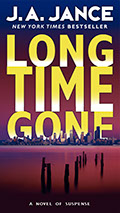 BUY NOWFIFTY YEARS AGO, WHEN SHE WAS FIVE, SISTER MARY KATHERINE WITNESSED SOMETHING TERRIBLE . . .
BUY NOWFIFTY YEARS AGO, WHEN SHE WAS FIVE, SISTER MARY KATHERINE WITNESSED SOMETHING TERRIBLE . . .
A former Seattle policeman now working for the Washington State Attorney's Special Homicide Investigation Team, J.P. Beaumont has been hand-picked to lead the investigation into a half-century-old murder. An eyewitness to the crime, a middle-aged nun, has now recalled grisly, forgotten details while undergoing hypnotherapy.
It's a case as cold as the grave, and it's running headlong into another that's tearing at Beau's heart: the vicious slaying of his former partner's ex-wife. What's worse, his rapidly unraveling friend is the prime suspect.
Caught in the middle of a lethal conspiracy that spans two generations and a killing that hits too close to home -- targeted by a vengeful adversary and tempted by a potential romance that threatens to reawaken his personal demons -- Beaumont may suddenly have more on his plate than he can handle, and far too much to survive.
Years ago, at a signing in Sierra Vista, a fan asked for my address, saying she wanted to send me something. Weeks later, a brown Manila envelope arrived.Inside were reports, detailing a case in which forgotten memories provided the impetus to clear a case some fifty years cold. The police reports were fascinating as was the fact that an accomplice, then in her eighties, actually went to prison for the crime. Run those police reports through the Waring Blender of my mind and fingers? Voila'! The result is Long Time Gone. J. P. Beaumont is definitely back!
JAJ
AVON (2005) ISBN 0-688-13824-1
 BUY NOWMURDER IS NEVER SIMPLE
BUY NOWMURDER IS NEVER SIMPLE
The investigation of LaShawn Tompkins's murder seems straightforward enough. Upon his release from death row, the ex-drug dealer returned to his old neighborhood, where he was gunned down on his mother's doorstep. Just another case of turf warfare.
At least that's what it looks like on the surface to Seattle investigator J. P. Beaumont, who's been handed the assignment under the strictest confidence. But as Beau starts digging, the situation becomes more complicated than he'd thought. It appears that LaShawn really had turned over a new leaf at the King Street Mission and his murder was premeditated. Someone had targeted the man for death.
Meanwhile, Beau's lover and fellow cop, Mel Soames, is given her own hush-hush investigation. A routine check on registered sex offenders has revealed a disturbing pattern: they're dying off at an alarming rate, and not all due to natural causes. Details of the latest death suggest an inside job, and Mel isn't letting this go.
Suddenly, Mel's investigation becomes entangled with Beau's, and the two begin to uncover a nightmarish conspiracy that could involve people in high places—including their own top brass.
HARPER SUSPENSE (2007) ISBN 0-006-05492-3
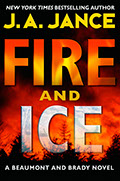 BUY NOWBEAUMONT AND BRADY
BUY NOWBEAUMONT AND BRADY
TOGETHER AGAIN
Six young women have been wrapped in tarps, doused with gasoline, and set on fire.
Their charred remains have been scattered around various dump sites, creating a grisly pattern of death across western Washington.
At the same time, thousands of miles away in the Arizona desert, Cochise County sheriff Joanna Brady is looking into a homicide in which the elderly caretaker of an ATV park was run over and left to die. All the man has left behind is his dog, who is the improbable witness to some kind of turf warfare—or possibly something more sinister.
Then a breakthrough in Beaumont's case leads him directly to the Southwest and into Brady's jurisdiction. When the two met on a joint investigation years earlier, sparks flew. Under different circumstances, both of them admit, even more could have happened.
But here, as the threads of their two seemingly separate cases wind together, Beaumont and Brady must put aside echoes of their shared past as they are once again drawn into an orbit of deception.
Cochise County, both in fiction and in real life, shares an 80 mile border with Mexico. I don't think I'm wrong when I say that smuggling both people and drugs is the county's biggest cash crop. Once the illicit drugs or immigrants land inside the US, the interstates become the distribution routes. With Bisbee on the southern end of that traffic and with Seattle at the far northern reaches, it's only natural the my two characters, J. P. Beaumont and Joanna Brady, would cross paths occasionally. Here's the second one of those.
JAJ
WILLIAM MORROW (2009) ISBN 978-0061239229
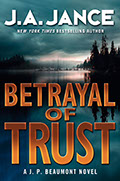 BUY NOWSEATTLE INVESTIGATOR J. P. BEAUMONT UNCOVERS A DARK AND DEADLY CONSPIRACY THAT REACHES DEEP INTO THE HALLS OF STATE GOVERNMENT.
BUY NOWSEATTLE INVESTIGATOR J. P. BEAUMONT UNCOVERS A DARK AND DEADLY CONSPIRACY THAT REACHES DEEP INTO THE HALLS OF STATE GOVERNMENT.
At first glance, the video appears to be showing a childish game: a teenage girl with dark wavy hair smiles for the camera, a blue scarf tied around her neck. All of a sudden things turn murderous, and the girl ends up dead.
It’s as bad as a snuff film can get, and what’s worse, the clip has been discovered on a phone that belongs to the grandson of Washington State’s governor. However, the boy, who has a troubled background, swears that he’s never seen the victim before.
Fortunately, the governor is able to turn to an old friend, J. P. Beaumont, for help. The Seattle private investigator has witnessed many horrific acts over the years, but this one ranks near the top. Even more shocking is that the crime’s multiple perpetrators could be minors.
Along with Mel Soames, his partner in life as well as on the job, Beaumont soon determines that what initially appears to be a childish prank gone wrong has much deeper implications. But Mel and Beau must follow this path of corruption to it's very end, before more innocent young lives are lost.
I finished writing Fatal Error on a Friday afternoon and e-mailed it to my editor. That evening my husband took me out to dinner to celebrate. In our house, I write the books and he writes the checks. While I had been dealing with plot and character and pacing, he had been watching the cash flow. Because the Ali book was delivered later that we expected, he could see that the cash flow was coming to a very tight place. So at dinner he asked me in what he thought was a completely inoffensive manner, "Have you given any thought to the next Beaumont book."
As in, "No pressure. Take the whole weekend off."
"Yes," I told him. I think I want the next Beaumont book to have something to do with the Washington state governor.
Bill looked at me, made a face, and said, "That's a terrible idea!"
I started writing Betrayal of Trust on Monday morning. I wrote the whole thing in just at two months. There's nothing like being mad as a wet hen to build up a good head of steam!!
JAJ
WILLIAM MORROW (2011) HARDCOVER: ISBN 978-0061731150; (2012) MASS MARKET PAPERBACK
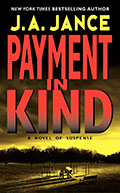 BUY NOWDEATH COMES OUT OF THE CLOSET
BUY NOWDEATH COMES OUT OF THE CLOSET
It looks like a classic crime of passion to Detective J. P. Beaumont: two corpses found lovingly entwined in a broom closet of the Seattle School District building. The prime suspect, Pete Kelsey, admits his slain spouse was no novice at adultery, yet he swears he had nothing to do with the brutal deaths of the errant school official and her clergyman-turned-security guard companion. Beau believes him, but there’s something the much sinned-upon widower’s not telling–and that spells serious trouble still to come. Because the secret Pete’s protecting is even hotter than extra-marital sex . . .and it could prove more lethal than murder.
As a desert rat moving to Seattle, I had no idea that a few inches of snow could bring the city to a complete halt with alarming regularity, usually just when children are going back to school after Christmas vacation. I wrote the blizzard scenes at the beginning of this book in September while I was sitting in a hotel room in Hawaii. When the book came out in February almost a year and a half later, I did a signing at a K-Mart in Lynnwood, Washington. A woman came marching up to the table and glowered down at the collection of books scattered across the table. “You’re real fast, aren’t you!” she said accusingly.
“Not really,” I said. “I’ve been writing these books since 1983.”
“That’s not what I mean,” she said. “That snow storm just happened three weeks ago.”
The character of Pete Kelsey was based on the husband of a friend of mine, a woman who was a book rep., selling my publisher’s books to the wholesalers who stocked books in grocery stores and airports and “better bus depots everywhere.” He was and is a highly sought-after and talented contractor to say nothing of an excellent cook. I’ve always hoped that he was pleased with his fictional depiction in this book.
JAJ
AVON (1991) ISBN 0-380-75836-9
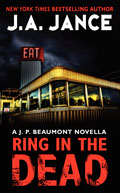 BUY NOWRING IN THE DEAD
BUY NOWRING IN THE DEAD
A J.P. BEAUMONT NOVELLA
Working with seasoned detective Milton Gurkey—a. k. a. Pickles—didn’t exactly start off as a solid partnership. Disgruntled at being stuck with a rookie, Pickles felt it was his duty to give Beaumont a hard time. But, when Pickles is suspected of murder, there’s only one person who can help him.
One day, a stop at the Doghouse restaurant quickly turns deadly. Not feeling well, Pickles steps out into the parking lot for a breath of fresh air and stumbles into a crime in progress In the same instant, he is felled by a sudden heart attack. Eventually, he’s found unconscious, with a dead woman on the ground nearby, and the murder weapon in his hand.
With Pickles under an Internal Affairs investigation, it's up to the new kid on the block, his partner, and friends on the force to uncover the truth.
WILLIAM MORROW: E-BOOK (2013) ISBN: 9780062291097; MASS MARKET PAPERBACK (2013) ISBN: 9780062294821
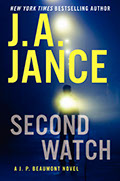 BUY NOWGETTING OLD IS HELL!
BUY NOWGETTING OLD IS HELL!
J. P. Beaumont is finally taking some time off to have his knee replacement surgery. But instead of taking his mind off work, the operation plunges him into one of the most perplexing and mind-blowing mysteries he's ever faced.
A series of dreams take him back to his early days on the force at Seattle P.D. and then, even earlier, to his days in Vietnam, reminding him of people and events he hasn't thought about in years.
His past collides with his present in this complex and thrilling story that explores loss and heartbreak, duty and honor, and, most importantly, the staggering cost of war and the debts we owe those who served in the Vietnam War, and those in uniform today.
READ THE STORY BEHIND SECOND WATCH
Second Watch includes a segment in which Beau meets up with a former schoolmate of mine, Doug Davis, a West Point graduate who died in Vietnam in 1966. Through the magic of fiction Beau and Doug meet and interact in Vietnam. In the book, Beau eventually also meets up with Bonnie Abney, the girl who was engaged to marry Doug at the time of his death.
Those of you who have read Second Watch already know that the back of the book contains a photo of Doug, that very real fallen hero from Bisbee. That photo, taken in Vietnam two days before Doug's death, came to light solely as a result of my writing Second Watch. As I was finishing the manuscript, a review copy of some of the material was sent to one of Doug's fellow West Point classmates. The piece was then forwarded to another classmate who went down into his basement and found the photo, hiding in a box where it had been left forgotten through all the intervening years. It arrived in Bonnie's life for the first time in an e-mail sent in early January.
There are almost 60,000 names on that wall in Washington. Bonnie and Doug's story of loving and losing is only one of them and yet it is emblematic of them all. Along the way we met up with several of those women, ones who had watched as the loves of their lives went off to the Vietnam War and came back home in flag-draped coffins.
JAJ
WILLIAM MORROW, HARDCOVER, SEPTEMBER 10, 2013, ISBN 978-0062134677
MASS MARKET PAPERBACK, HARPER, APRIL 29, 2014
Until Proven Guilty
Injustice for All
Trial by Fury
Taking the Fifth
Improbable Cause
A More Perfect Union
Dismissed with Prejudice
Minor in Possession
Without Due Process
Failure to Appear
Lying in Wait
Name Withheld
Breach of Duty
Birds of Prey
Partner in Crime
Long Time Gone
Justice Denied
Fire and Ice
Betrayal of Trust
Payment in Kind
Ring in the Dead
Second Watch
AUTOGRAPHED COPIES
BOOK LIST
PUBLISHER J.A. Jance PAGES
SHORT STORIES & INDIE BOOKSTORES